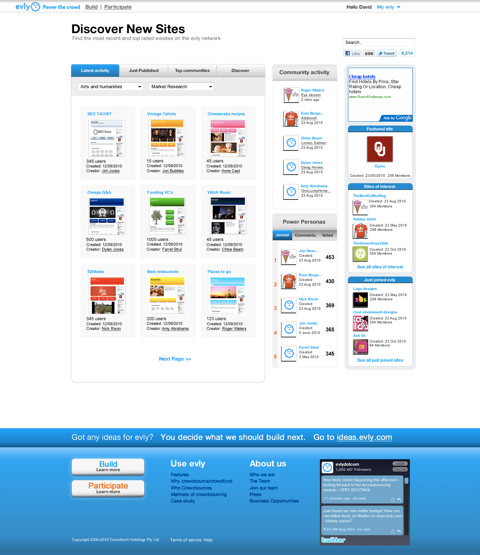We all have them. Those apps we open without thinking. Not because we need anything in particular, but because they feel… safe, in some…
Evly.com first look: Will this new crowdsourcing social network work?
 Sometimes it just so happens that a new technology service really speaks to you. The first time I saw Groupon, I thought that it was one of the most compelling services seen in quite some time. Clearly I was not the only one. Google is rumoured to have made an offer to acquire Groupon for US$3-billion.
Sometimes it just so happens that a new technology service really speaks to you. The first time I saw Groupon, I thought that it was one of the most compelling services seen in quite some time. Clearly I was not the only one. Google is rumoured to have made an offer to acquire Groupon for US$3-billion.
My first look at Evly however did not elicit quite the same initial reaction.
The crowdsourcing social network had a soft launch this month. Its founder, Eran Eyal, of Springleap fame, touted their efforts as cutting-edge and having the potential to revolutionise the internet. Based on mathematical models for businesses with viral loops, he ambitiously described a scenario that could see Evly amass “over 36-million users in its first 18 months”. If this came true, it would easily make it the fastest growing website on the African continent.
Some have rightly pointed out that Eyal and his business partner Eric Edelstein have had local success over the last three years via their T-Shirt crowdsourcing startup, Springleap. Based on the popular Threadless, Springleap’s local focus sees the company using 3 500 artists who form a part of a community of about 25 000 subscribers. That’s great, but its a rather long way off from 36-million users.
It may not be wise to take the success of Springleap to predict Evly’s fate. There is no doubt that Eyal and Edelstein are savvy entrepreneurs, but can taking the Springleap crowdsourcing model and handing the keys to the public really produce similar success stories?
With Evly, the idea is to give anyone the ability to create initiatives based on crowdsourcing. I wouldn’t be surprised if someone attempted to create another version of Springleap using Evly, but success depends largely on the people driving the initiatives and not necessarily the tools they use to build them.
Hands-on with Evly’s site building tool
Evly’s site-building tool is at the heart of the service, allowing businesses and individuals to source input from the members that become part of their social network. Very simply put, you can think of the tool as a Ning social network, with a Q&A element added to it.
You start by choosing from a list of pre-defined themes. Next is the most critical part: You are presented with a list of templates. Depending on the template you choose, your Evly social network will have a certain design to facilitate the particular crowdsourcing input you are looking for. The templates currently available are “Ideas”, “Answers”, “Solutions”, “Designs”, “Advice”, and “People”, with “Money” shortly to follow.
If none of these templates are useful, you are also free to create your own using the “Custom” option — for example, if you’d like to source friends for a party you’re having.
Each of the templates have more fine-grained setup options. If you choose the “People” template you can select to source people for business, projects or research. If you choose the “Designs” template, you can select to source designs for business, projects or products.

The final parts of the template setup allow you to choose whether the sourcing will be done by yourself or the crowd, as well as the approval process for new challenges, challenge deadlines and comments and voting preferences. Lastly, you choose the name for your Evly social network which will be something like “testsite.evly.com”.
Once the setup process is complete you are presented with a drag-and-drop editor to customise your site’s template. This is one area in which Evly really shines. One senses a great effort to keep things as simple as possible while still allowing for fairly deep customisation. You can drag-and-drop objects, edit text elements, add widgets and edit navigation bar options all in one place thanks to in-line editing and generous use of modal windows.
When you’re ready, you are able to publish your site. At this point users can join your social network, communicate within it and of course contribute to any of the challenges you are hoping to crowdsource solutions for.
You are not limited to just one crowdsourcing social network. If you are a fashion designer, you could crowdsource ideas and solutions around winter and summer collections by creating different social networks around each, such as “gucci-summer-collection.evly.com” and “gucci-winter-collection.evly.com”.
Thankfully a dashboard provides an overview of site analytics, members, site customisation and feedback management for your challenges across all your different sites.
Too close to Ning?
It feels like Evly has a crush on Ning, but is that a good thing? In April of this year Ning announced that they would cut 40% of their staff, phase out their free service and focus on revenue from premium services only. Will Evly be able to continue to provide their free level 1 starter service indefinitely, or will they too be forced to focus on their level 2 and 3 paid services, white label agreements and software licensing plans?
Eyal mentioned the use of cloud services, but no specifics. On closer inspection it seems Evly currently runs on a Microsoft Dynamic Hosting cloud service. The service is ASP-powered and resides on a Microsoft IIS 7 web server. If Evly indeed manages to amass its rather dramatic claims of “36-million users”, how will this architecture scale? Given the two-year design period for Evly, an open source framework such as Rails could have sped up design time substantially thanks to the many freely available code libraries.
Crowdsourcing does not happen spontaneously and Evly should perhaps encourage compensation incentives to members of the crowd who participate in challenges by baking it into the system. If the crowd knows upfront what they can gain from participating, they are more likely to participate. Right now incentives are optional.
In its beta form Evly’s UI is a bit cluttered in places, but one senses that it can and will mature over time. With that said, one of the reasons for the clutter is perhaps that Evly is trying to do too much at once.
Niches for each of the different crowdsourcing templates Evly currently provides already exist, for example:
-
– Social Networking: Ning
– Ideas: Ideascale
– Answers: Quora
– Solutions: Ideabounty
– Designs : Dribbble
– Advice: Getsatisfaction
– Money: Kickstarter
– People: Monster
The difference with Evly is that they are together in one place. Time will tell if that is a positive or a negative.
For Evly to succeed it should focus on its strengths and do away with the noise. The idea of unifying the different crowdsourcing niches under one roof is a good one, but there is a real danger that the brilliance of it gets buried under less useful elements.
Do companies and individuals really need an entire new micro-site or social network if all they want to do is source solutions to a burning question? If Evly could somehow package its crowdsourcing solution and provide it as a plugin then things could get really interesting.
What if I had a WordPress site, and I wanted to implement a crowdsourcing element? Instead of linking to my Evly social network, I could utilise my WordPress site’s built-in social elements and use an Evly Q&A plugin to source solutions for my regular visitors.
It will be the actions of the crowd over the coming months that will determine the fate of this crowdsourcing social network.
